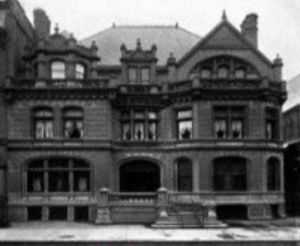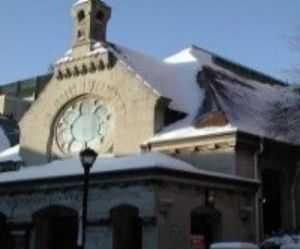Related Topics
West of Broad
A collection of articles about the area west of Broad Street, Philadelphia, Pennsylvania.
Particular Sights to See:Center City
Taxi drivers tell tourists that Center City is a "shining city on a hill". During the Industrial Era, the city almost urbanized out to the county line, and then retreated. Right now, the urban center is surrounded by a semi-deserted ring of former factories.
Great Depression (1929-1939)
New topic 2012-08-29 11:32:11 description
Northwest Rittenhouse Square

|
| {John Wanamaker's Mansion 2032 Walnut Street |
Market, Chestnut and Walnut Streets go right across the Schuylkill on bridges; that fact was once their glory, but now is the source of their problem. The first bridge to be built, at Market Street, was originally placed there in 1804. Placing your mansion on an important street makes you prominent, but if the street gets too busy, crowded and noisy you eventually wish you lived somewhere else. Air conditioning helps somewhat by allowing your windows to be closed all the time, but eventually, the increasing commercial value of the location gives you unwelcome neighbors. So right now the last few blocks of Chestnut and Walnut before you reach the river are pretty run down. Students from the Universities on the far side of the river make for street activity at night, but most of them head for the Eastern edge of Rittenhouse Square, where droves of them sit at sidewalk tables on a summer evening. Irreverent college kids refer to such a congregation as a meat market, but I'm only quoting them.
John Wanamaker had one of his many mansions just past the Square at 2032 Walnut, but it now is mostly an entrance to an apartment building towering above it. What now distinguishes this area most are the surviving churches.

|
| Unitarian Church |
The Unitarian Church at 22nd and Chestnut is one of Frank Furness' finest buildings and next to it is a renovated former Church of the New Jerusalem (Swedenborgian Church), now used for an advertising agency. Frank Furness won the Medal of Honor during the Civil War before he thought much about architecture. Swedenborg, for his part, founded what is known as a thinking man's religion, since Emanuel Swedenborg (1688-1772) himself was a scientist of the first rank who might have won a Nobel Prize if there had been such a thing in his day. The Mother Church of this religion moved out to Bryn Athyn, abandoning the center city after what is reported to be a heated dispute. While the new cathedral is absolutely spectacular, the old one on Chestnut Street is still pretty fine, itself.
Across Chestnut Street is the Lutheran Church, which proves to be astonishingly large when you enter it, and it has great acoustical qualities related to the Moravian influences of the last century. Up at the NorthWest corner of Rittenhouse Square is Holy Trinity. Its minister, Phillips Brooks, wrote the words of the Christmas carol "O Little Town of Bethlehem", which are a poem of considerable merit and sophistication. Unfortunately, the need to adjust these words to music which children might single to the attachment of three different tunes of less than classic musical proportions, sometimes even less sonorous when sung simultaneously by adults who remember different tunes from their childhood. In view of the far from the peaceful scene of present-day Bethlehem, at least the message of the carol warrants recollection indeed. And, yes, the church is reddish brown in color, as most Episcopalian churches seem to be.
There once was a time when Anthony Drexel walked down Walnut Street to work every day. One can easily imagine him tipping his hat to passers-by, striding along in front of formerly elegant mansions which line the street but are now too big to maintain. This area was a place of show houses, of downtown places to hold parties during the social season, from thence fleeing to a second house in the suburbs, or in Maine, or in Europe, during the summer. The Great Depression of the 1930s forced most of these people to choose between their various residences, and because of the advent of the automobile, they mostly chose the other places, abandoning these. It was the end of the Gilded age.
For a tour of Rittenhouse Square, mentioned in this Reflection, visit Seven Tours Through Historic Philadelphia
Originally published: Thursday, July 24, 1997; most-recently modified: Wednesday, May 29, 2019